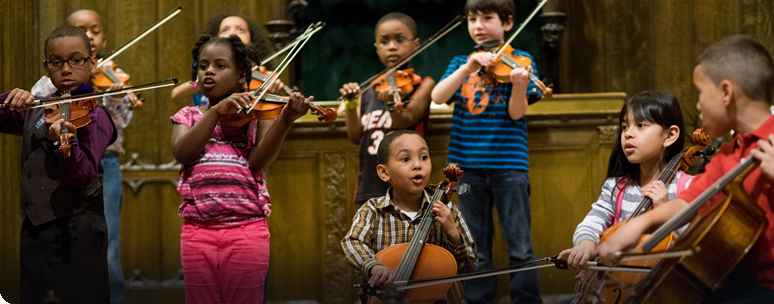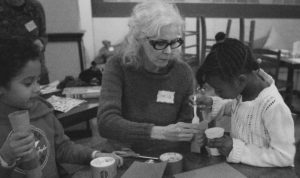Talking and Listening: Behind the Scenes of 20 Years, 20 Stories
Linda Daniels is a writer, editor, cellist, CMW parent, former CMW Board member and expert eavesdropper. She helms the 20 Years, 20 Stories project and this is her story. I’ve been an eavesdropper since childhood. My mother liked to pour herself a Royal Crown cola in the late afternoon, park herself on the couch and telephone her mother, which was my cue to c-a-r-e-f-u-l-l-y raise the extension handset upstairs. Usually, they discussed mundane matters: pork chops versus chicken, how this season’s fashions were so unflattering and, now and then, family gossip. The topics were almost beside the point, except for the family gossip, which is why I eavesdropped in the first place. But I was also intrigued by the mysterious current of poetry running beneath even the most routine remarks. I loved the give and take of conversation, the sighs and pauses, the sound of my mother’s sympathetic tsk-tsk’s and my grandmother’s pretty brogue. I almost always got busted and was scolded, but not seriously enough to deter me from future attempts. Talking was as close as my family got to making music. No one sang or played an instrument, and my relatives just embarrassed themselves trying to clap along to music, but man, could these people talk. Listeners, even illicit ones, had a role to play, too. We completed the performance circle. In college, Studs Terkel’s oral history Working: People Talk About What They Do All Day and How They Feel About What They Do shaped my senior year thesis. I made the leap from habitual eavesdropper to scholarly interviewer and collected the oral histories of women who came of age during the 1920s. The best parts of the resulting 200-plus-page door-stopper were their reminiscences. After college, I became a reporter: more listening, more writing. Even after I quit newspapers and turned to other pursuits, I never lost the eavesdropping habit. My husband recognizes the faraway look that crosses my face when we’re in a public space and I hear something that bears further investigation, convinced, of course, that no one can tell what I’m up to. After 27 years, he also knows that whatever he and I were talking about will have to wait. More recently, I’ve been inspired by writer Svetlana Alexievich, who won a Nobel for Secondhand Time, her beautifully rendered oral history of post-Soviet Russians. In September, I began an exciting new listening and writing project in connection with Community MusicWorks’ 20th anniversary: collecting 20 representative stories of CMW musicians, staff, students, parents and supporters. I’ve been expertly assisted by CMW fellow Josie Davis, who interviewed three people, and Communications Manager Liz Cox, who proofreads the stories and designs the online content. (Read the stories here.) It hasn’t been difficult to get people to open up. I’ve been a familiar face at CMW since my youngest had his first cello lesson here ten years ago. I’ve exchanged knowing glances with other parents when a beginner nails “Twinkle” and held a collective breath during the dying notes of a Beethoven quartet performed by the pros. I’ve square-danced to fiddle tunes and attempted, much less successfully, the salsa. I’ve sung rounds and set up folding chairs; fretted over budgets and strategic goals; eased my car past side-view mirrors on snow-bound Messer Street; knitted for newborns; and eaten far too much pizza. Since people know me better as an at-large mom than as an interviewer and writer, some of my questions may discomfit. Recently, a student I was interviewing put up a hand and blurted, “That’s a weird question!” Um, ok. But can you answer it anyway? I remain confident that what I’m curious about others are too. She answered in good faith, trusting that I have her back. I am honored by that trust. You readers should be also. When people talk honestly they make themselves vulnerable. They don’t want to be misconstrued as they describe emotions and realizations that can’t be summarized by facts alone. This is especially true of CMW’s staff, who are talking about their life’s work. It’s why I take the final step of the oral history process so seriously: converting 8-20 pages of interview transcript to a narrative that honors the speaker’s intentions, captures history while it’s still occurring, and compels readers. It’s a messy process. No matter how cleverly I order the questions and pursue answers during an interview, the talk meanders, as talk will. Even the most prepared and polished speakers wander off topic and speak colloquially, thank goodness. They are thinking out loud, which is where the music happens. It’s the difference between watching an official read a prepared statement from behind a podium and hearing him speak spontaneously from the heart when a reporter surprises him off-stage by asking exactly the right question at the right moment. I’m going for the latter. Some “20 Years, 20 Stories” subjects have been flummoxed by the difference between the hour-plus interview they remember and the 2-5 page story I produce, having edited and condensed our conversation to a fare-thee-well, absenting my questions along the way. (Available here, if you’re curious.) They worry about being misperceived and about sounding too casual. They worry that they have said too much or too little. It is scary to see your constantly morphing thoughts marching in regimental black lines across white space. Where are the raised eyebrows signaling sincerity or the smile signaling warmth? Where are the tears that welled up when recalling a triumphant moment with a challenging student? Where’s a second or third chance to rephrase? To be more thoughtful? To explain more fully? Oral history and chamber music have much in common. Both art forms strive to capture human experience through artifice and collaborative effort, and both are very much of the moment. Therein lies the thrill. Having made the artistic decision to omit interview questions in favor of narrative flow, I don’t worry that readers need cue cards. I trust that readers will appreciate what I appreciate about oral history: the idiosyncratic quirks of everyday speech as thoughtful people talk about things that matter. Subjects can trust their beautiful, one-of-a-kind voices to tell the story. The rest of us can pick up the extension and listen in. |

